Generation Gaps Training Manual: A Guide for Managers and Co-workers
VerifiedAdded on 2023/01/06
|31
|8892
|51
Report
AI Summary
This document is a comprehensive training manual designed to address the challenges and opportunities presented by generation gaps in the workplace. The manual begins by defining the concept of generation gaps and outlining the objectives of the training program. It then delves into the historical context of these gaps, explaining how different generations have been shaped by their unique experiences and societal influences. The core of the manual focuses on detailed profiles of each generation currently present in the workforce, including Traditionalists, Baby Boomers, Generation X, Generation Y (Millennials), and Generation Z. Each profile covers the generation's background, key characteristics, and preferred working styles. The manual also addresses practical strategies for finding common ground among generations, improving communication, and managing conflicts that may arise. The manual incorporates real-world examples, activities, and case studies to facilitate learning and promote the development of effective leadership and interpersonal skills. The goal is to equip managers and co-workers with the knowledge and tools they need to create a respectful, productive, and harmonious work environment where all generations can thrive. The manual emphasizes the importance of understanding generational differences to enhance collaboration, boost morale, and achieve organizational success.
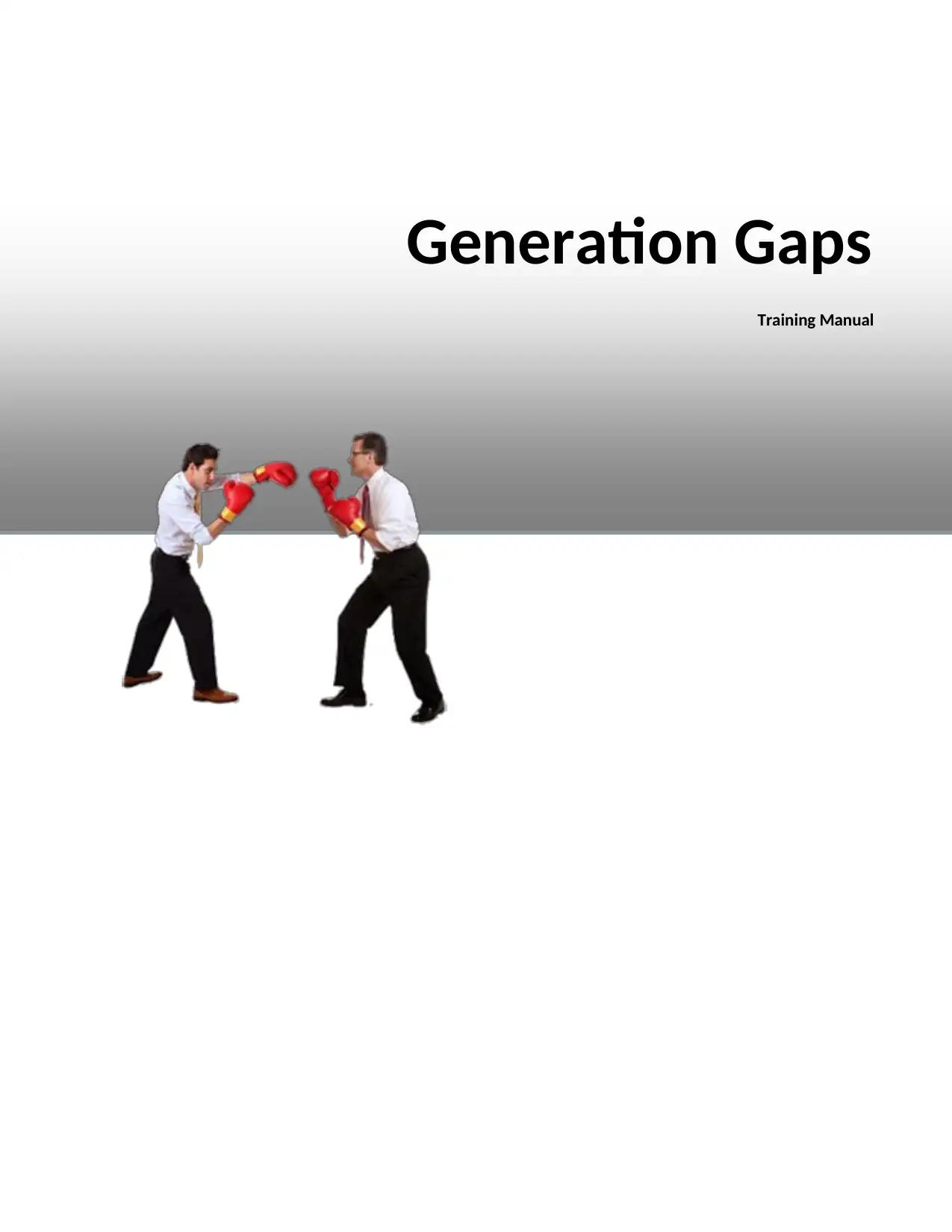
Generation Gaps
Training Manual
Training Manual
Paraphrase This Document
Need a fresh take? Get an instant paraphrase of this document with our AI Paraphraser
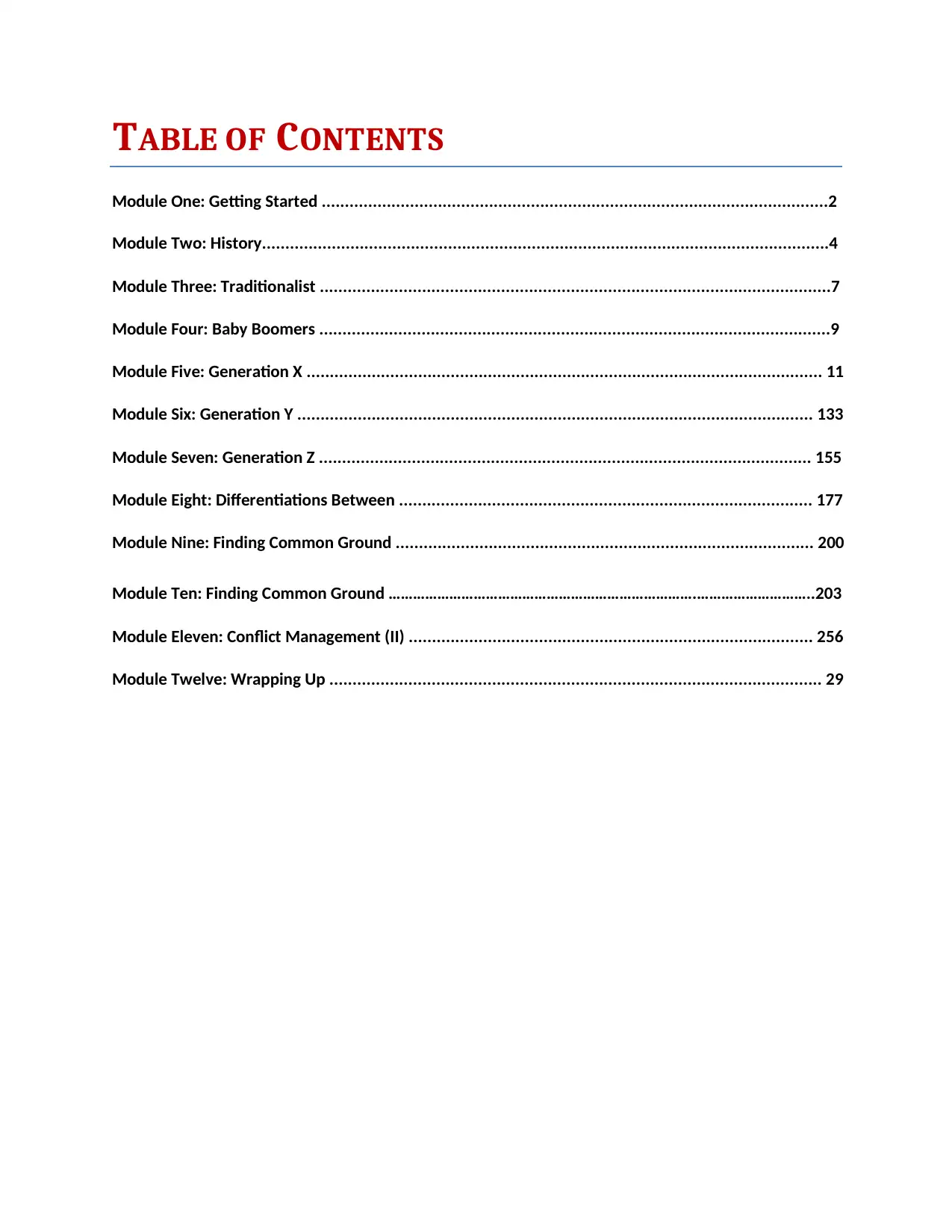
TABLE OF CONTENTS
Module One: Getting Started .............................................................................................................2
Module Two: History..........................................................................................................................4
Module Three: Traditionalist ..............................................................................................................7
Module Four: Baby Boomers ..............................................................................................................9
Module Five: Generation X ............................................................................................................... 11
Module Six: Generation Y ............................................................................................................... 133
Module Seven: Generation Z .......................................................................................................... 155
Module Eight: Differentiations Between ......................................................................................... 177
Module Nine: Finding Common Ground .......................................................................................... 200
Module Ten: Finding Common Ground ………………………………………………………………….………………………..203
Module Eleven: Conflict Management (II) ....................................................................................... 256
Module Twelve: Wrapping Up .......................................................................................................... 29
Module One: Getting Started .............................................................................................................2
Module Two: History..........................................................................................................................4
Module Three: Traditionalist ..............................................................................................................7
Module Four: Baby Boomers ..............................................................................................................9
Module Five: Generation X ............................................................................................................... 11
Module Six: Generation Y ............................................................................................................... 133
Module Seven: Generation Z .......................................................................................................... 155
Module Eight: Differentiations Between ......................................................................................... 177
Module Nine: Finding Common Ground .......................................................................................... 200
Module Ten: Finding Common Ground ………………………………………………………………….………………………..203
Module Eleven: Conflict Management (II) ....................................................................................... 256
Module Twelve: Wrapping Up .......................................................................................................... 29
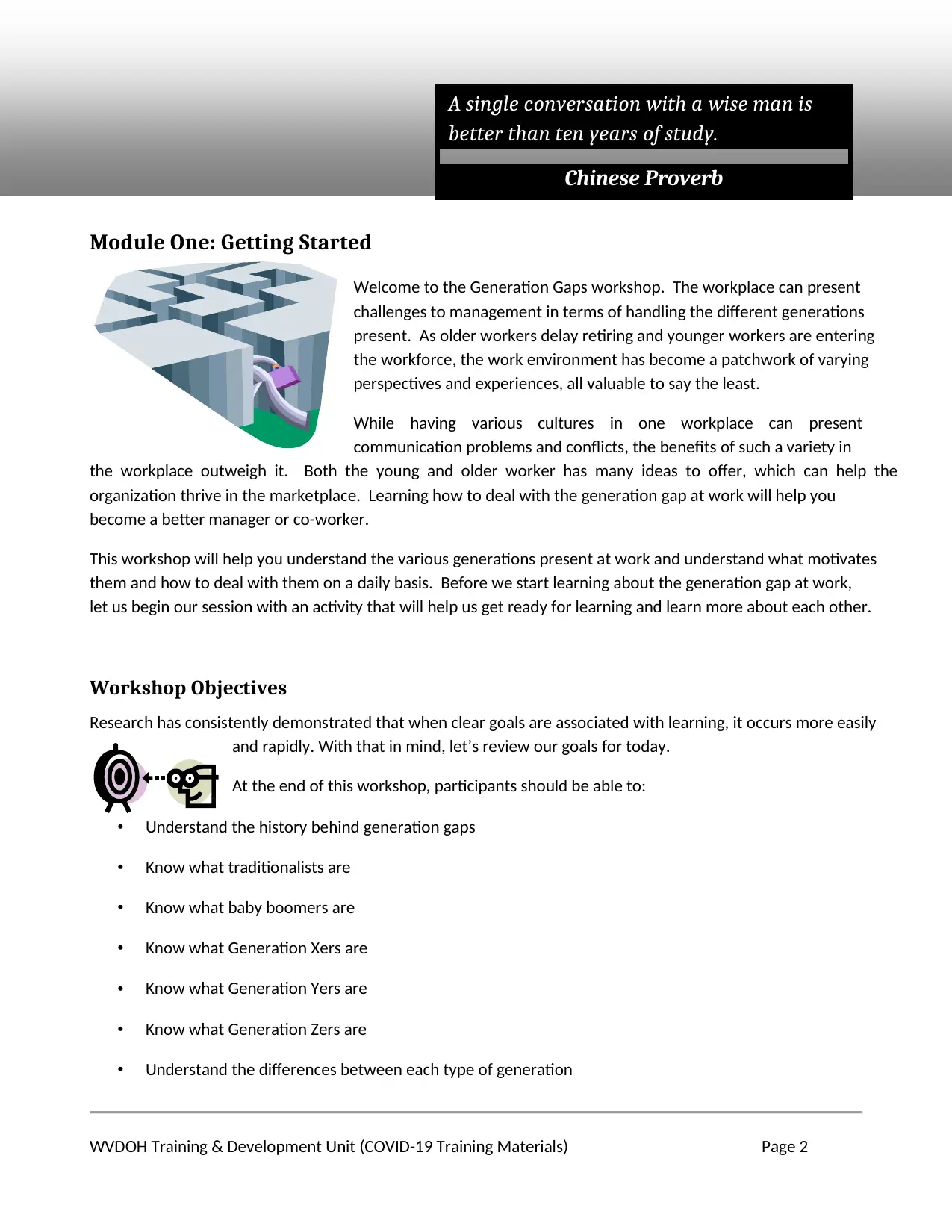
WVDOH Training & Development Unit (COVID-19 Training Materials) Page 2
Module One: Getting Started
Welcome to the Generation Gaps workshop. The workplace can present
challenges to management in terms of handling the different generations
present. As older workers delay retiring and younger workers are entering
the workforce, the work environment has become a patchwork of varying
perspectives and experiences, all valuable to say the least.
While having various cultures in one workplace can present
communication problems and conflicts, the benefits of such a variety in
the workplace outweigh it. Both the young and older worker has many ideas to offer, which can help the
organization thrive in the marketplace. Learning how to deal with the generation gap at work will help you
become a better manager or co-worker.
This workshop will help you understand the various generations present at work and understand what motivates
them and how to deal with them on a daily basis. Before we start learning about the generation gap at work,
let us begin our session with an activity that will help us get ready for learning and learn more about each other.
Workshop Objectives
Research has consistently demonstrated that when clear goals are associated with learning, it occurs more easily
and rapidly. With that in mind, let’s review our goals for today.
At the end of this workshop, participants should be able to:
• Understand the history behind generation gaps
• Know what traditionalists are
• Know what baby boomers are
• Know what Generation Xers are
• Know what Generation Yers are
• Know what Generation Zers are
• Understand the differences between each type of generation
A single conversation with a wise man is
better than ten years of study.
Chinese Proverb
Module One: Getting Started
Welcome to the Generation Gaps workshop. The workplace can present
challenges to management in terms of handling the different generations
present. As older workers delay retiring and younger workers are entering
the workforce, the work environment has become a patchwork of varying
perspectives and experiences, all valuable to say the least.
While having various cultures in one workplace can present
communication problems and conflicts, the benefits of such a variety in
the workplace outweigh it. Both the young and older worker has many ideas to offer, which can help the
organization thrive in the marketplace. Learning how to deal with the generation gap at work will help you
become a better manager or co-worker.
This workshop will help you understand the various generations present at work and understand what motivates
them and how to deal with them on a daily basis. Before we start learning about the generation gap at work,
let us begin our session with an activity that will help us get ready for learning and learn more about each other.
Workshop Objectives
Research has consistently demonstrated that when clear goals are associated with learning, it occurs more easily
and rapidly. With that in mind, let’s review our goals for today.
At the end of this workshop, participants should be able to:
• Understand the history behind generation gaps
• Know what traditionalists are
• Know what baby boomers are
• Know what Generation Xers are
• Know what Generation Yers are
• Know what Generation Zers are
• Understand the differences between each type of generation
A single conversation with a wise man is
better than ten years of study.
Chinese Proverb
⊘ This is a preview!⊘
Do you want full access?
Subscribe today to unlock all pages.

Trusted by 1+ million students worldwide
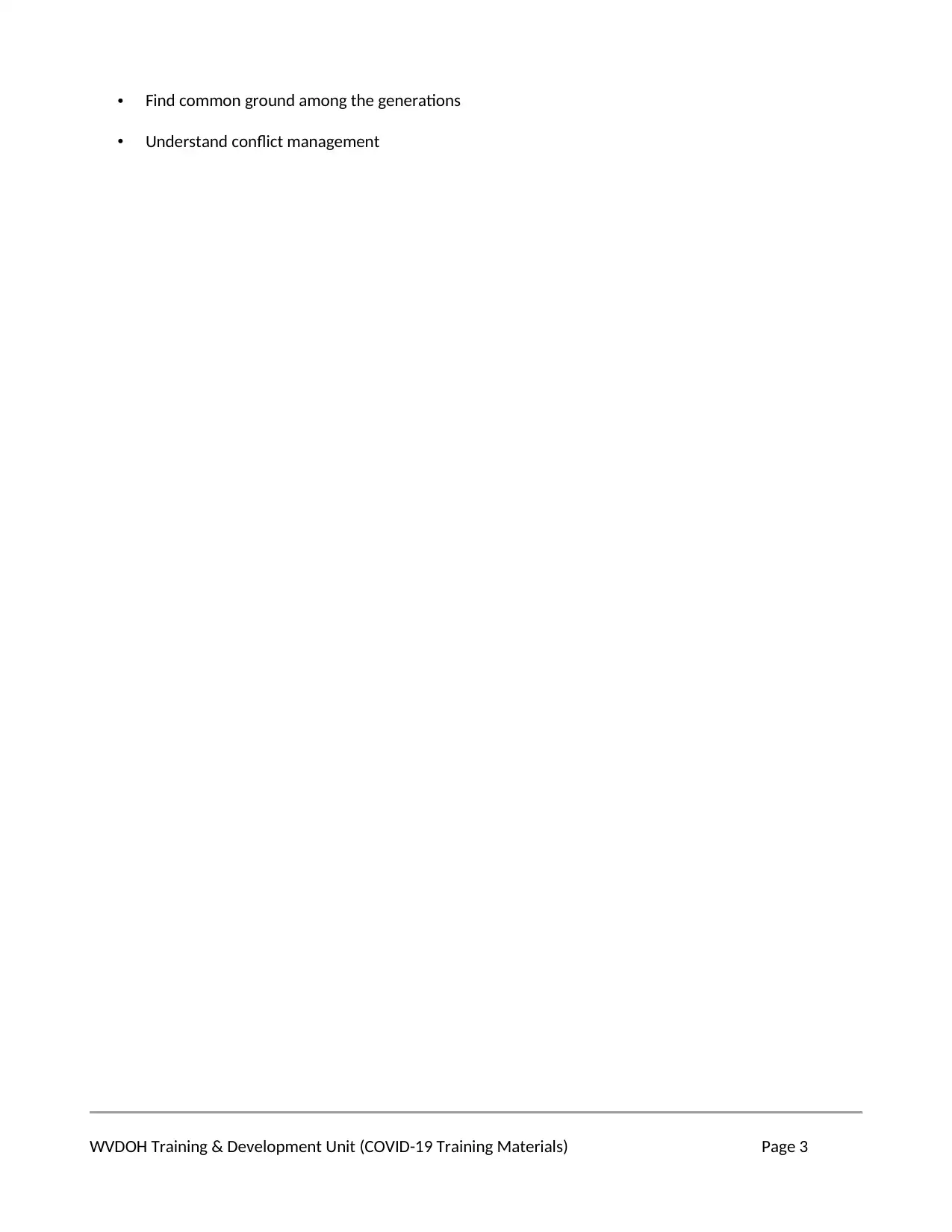
WVDOH Training & Development Unit (COVID-19 Training Materials) Page 3
• Find common ground among the generations
• Understand conflict management
• Find common ground among the generations
• Understand conflict management
Paraphrase This Document
Need a fresh take? Get an instant paraphrase of this document with our AI Paraphraser

WVDOH Training & Development Unit (COVID-19 Training Materials) Page 4
Module Two: History
The term generation gap is a term used to describe the different values and
attitudes between one generation and another. This term is typically used
to describe the gap between parents and their children.
Since the 1960’s, the term generation gap has also been used to describe
the clash one age group has with another in various settings. The workplace
is such an environment where different generations must intermingle and
deal with each other’s way of thinking.
This module will discuss the following topics as it relates to the generation
gap in the workplace:
• What generations exist in the workplace
• What defines a generation
• What this means in our workplace
Let us begin by understanding what generations exist in the workplace.
What Generations Exist in the Workplace
Today’s workplace presents many challenges that are based solely on meeting goals,
business objectives, and project deadlines. Threaded throughout the normal business
activities are dynamics that could present issues and conflicts if left unchecked.
Since many older workers remain on the job longer and younger workers are entering
the workplace right out of college, the work environment is fragmented into various
generations. In order to understand this eclectic environment, it is necessary to understand what generations
are present in today’s workplace.
Because humans live on average 77 to 80 years, four potential generations may exist in the workplace today.
The five generations that could be present are the following:
Each generation wants new symbols, new
people, new names. They want to divorce
themselves from their predecessors.
Jim Morrison
Module Two: History
The term generation gap is a term used to describe the different values and
attitudes between one generation and another. This term is typically used
to describe the gap between parents and their children.
Since the 1960’s, the term generation gap has also been used to describe
the clash one age group has with another in various settings. The workplace
is such an environment where different generations must intermingle and
deal with each other’s way of thinking.
This module will discuss the following topics as it relates to the generation
gap in the workplace:
• What generations exist in the workplace
• What defines a generation
• What this means in our workplace
Let us begin by understanding what generations exist in the workplace.
What Generations Exist in the Workplace
Today’s workplace presents many challenges that are based solely on meeting goals,
business objectives, and project deadlines. Threaded throughout the normal business
activities are dynamics that could present issues and conflicts if left unchecked.
Since many older workers remain on the job longer and younger workers are entering
the workplace right out of college, the work environment is fragmented into various
generations. In order to understand this eclectic environment, it is necessary to understand what generations
are present in today’s workplace.
Because humans live on average 77 to 80 years, four potential generations may exist in the workplace today.
The five generations that could be present are the following:
Each generation wants new symbols, new
people, new names. They want to divorce
themselves from their predecessors.
Jim Morrison
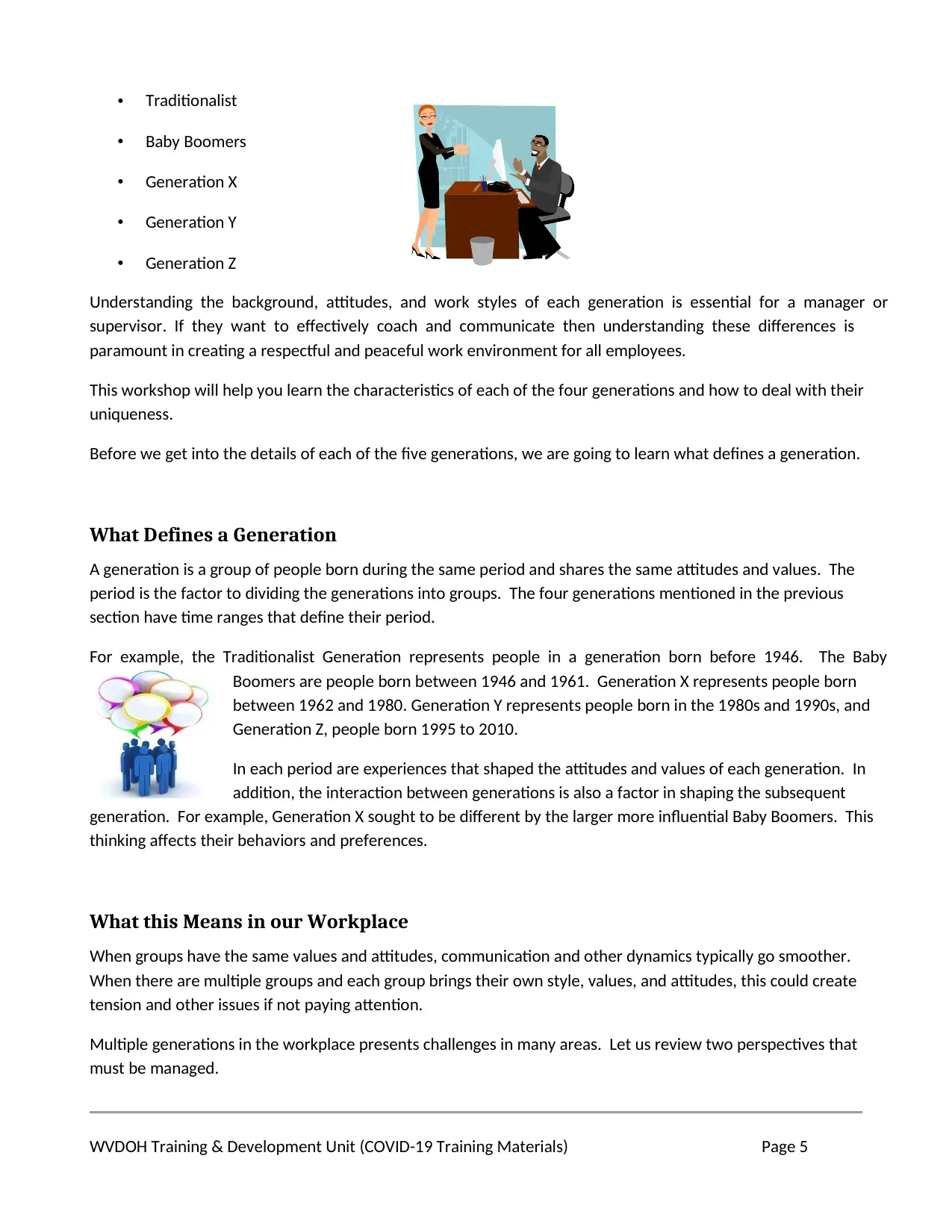
WVDOH Training & Development Unit (COVID-19 Training Materials) Page 5
• Traditionalist
• Baby Boomers
• Generation X
• Generation Y
• Generation Z
Understanding the background, attitudes, and work styles of each generation is essential for a manager or
supervisor. If they want to effectively coach and communicate then understanding these differences is
paramount in creating a respectful and peaceful work environment for all employees.
This workshop will help you learn the characteristics of each of the four generations and how to deal with their
uniqueness.
Before we get into the details of each of the five generations, we are going to learn what defines a generation.
What Defines a Generation
A generation is a group of people born during the same period and shares the same attitudes and values. The
period is the factor to dividing the generations into groups. The four generations mentioned in the previous
section have time ranges that define their period.
For example, the Traditionalist Generation represents people in a generation born before 1946. The Baby
Boomers are people born between 1946 and 1961. Generation X represents people born
between 1962 and 1980. Generation Y represents people born in the 1980s and 1990s, and
Generation Z, people born 1995 to 2010.
In each period are experiences that shaped the attitudes and values of each generation. In
addition, the interaction between generations is also a factor in shaping the subsequent
generation. For example, Generation X sought to be different by the larger more influential Baby Boomers. This
thinking affects their behaviors and preferences.
What this Means in our Workplace
When groups have the same values and attitudes, communication and other dynamics typically go smoother.
When there are multiple groups and each group brings their own style, values, and attitudes, this could create
tension and other issues if not paying attention.
Multiple generations in the workplace presents challenges in many areas. Let us review two perspectives that
must be managed.
• Traditionalist
• Baby Boomers
• Generation X
• Generation Y
• Generation Z
Understanding the background, attitudes, and work styles of each generation is essential for a manager or
supervisor. If they want to effectively coach and communicate then understanding these differences is
paramount in creating a respectful and peaceful work environment for all employees.
This workshop will help you learn the characteristics of each of the four generations and how to deal with their
uniqueness.
Before we get into the details of each of the five generations, we are going to learn what defines a generation.
What Defines a Generation
A generation is a group of people born during the same period and shares the same attitudes and values. The
period is the factor to dividing the generations into groups. The four generations mentioned in the previous
section have time ranges that define their period.
For example, the Traditionalist Generation represents people in a generation born before 1946. The Baby
Boomers are people born between 1946 and 1961. Generation X represents people born
between 1962 and 1980. Generation Y represents people born in the 1980s and 1990s, and
Generation Z, people born 1995 to 2010.
In each period are experiences that shaped the attitudes and values of each generation. In
addition, the interaction between generations is also a factor in shaping the subsequent
generation. For example, Generation X sought to be different by the larger more influential Baby Boomers. This
thinking affects their behaviors and preferences.
What this Means in our Workplace
When groups have the same values and attitudes, communication and other dynamics typically go smoother.
When there are multiple groups and each group brings their own style, values, and attitudes, this could create
tension and other issues if not paying attention.
Multiple generations in the workplace presents challenges in many areas. Let us review two perspectives that
must be managed.
⊘ This is a preview!⊘
Do you want full access?
Subscribe today to unlock all pages.

Trusted by 1+ million students worldwide
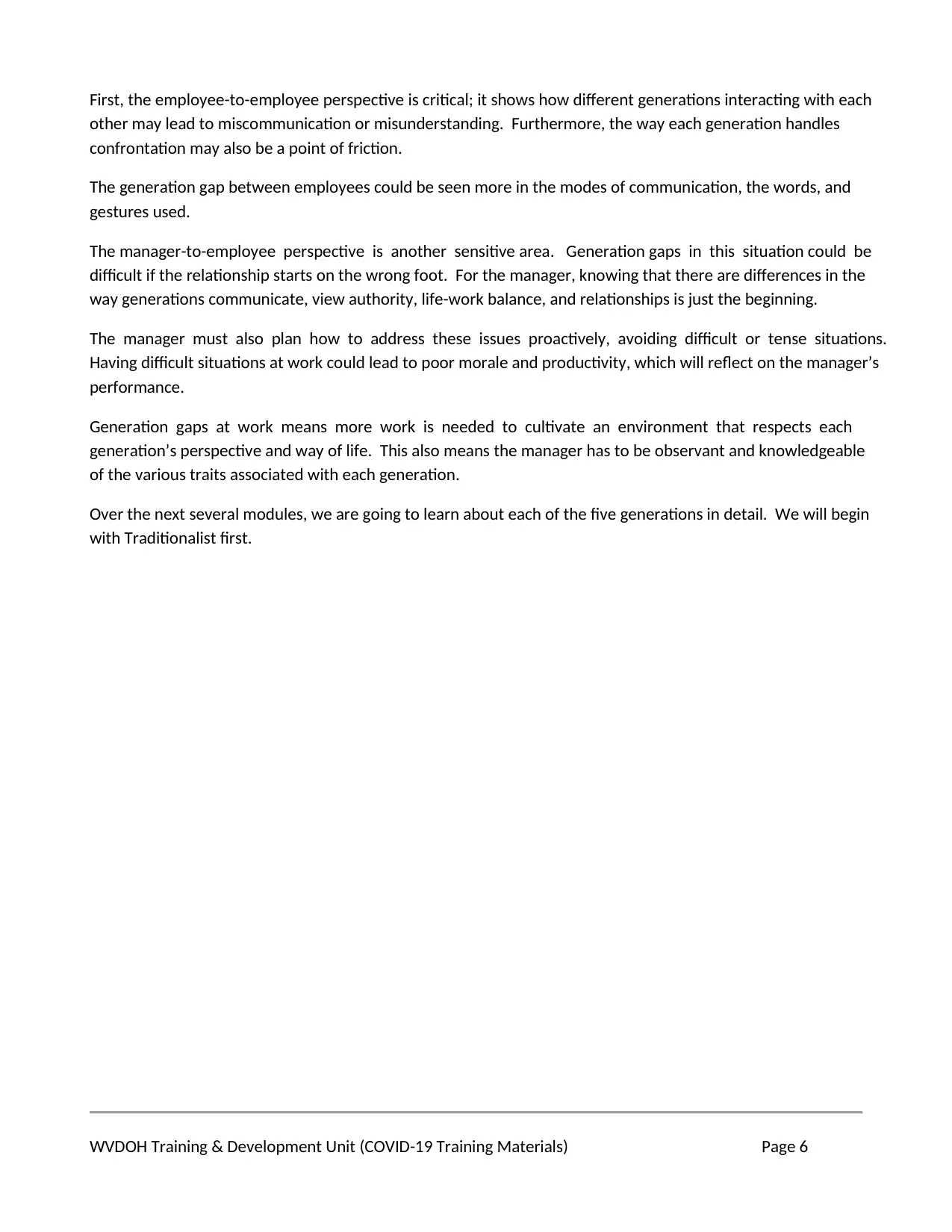
WVDOH Training & Development Unit (COVID-19 Training Materials) Page 6
First, the employee-to-employee perspective is critical; it shows how different generations interacting with each
other may lead to miscommunication or misunderstanding. Furthermore, the way each generation handles
confrontation may also be a point of friction.
The generation gap between employees could be seen more in the modes of communication, the words, and
gestures used.
The manager-to-employee perspective is another sensitive area. Generation gaps in this situation could be
difficult if the relationship starts on the wrong foot. For the manager, knowing that there are differences in the
way generations communicate, view authority, life-work balance, and relationships is just the beginning.
The manager must also plan how to address these issues proactively, avoiding difficult or tense situations.
Having difficult situations at work could lead to poor morale and productivity, which will reflect on the manager’s
performance.
Generation gaps at work means more work is needed to cultivate an environment that respects each
generation’s perspective and way of life. This also means the manager has to be observant and knowledgeable
of the various traits associated with each generation.
Over the next several modules, we are going to learn about each of the five generations in detail. We will begin
with Traditionalist first.
First, the employee-to-employee perspective is critical; it shows how different generations interacting with each
other may lead to miscommunication or misunderstanding. Furthermore, the way each generation handles
confrontation may also be a point of friction.
The generation gap between employees could be seen more in the modes of communication, the words, and
gestures used.
The manager-to-employee perspective is another sensitive area. Generation gaps in this situation could be
difficult if the relationship starts on the wrong foot. For the manager, knowing that there are differences in the
way generations communicate, view authority, life-work balance, and relationships is just the beginning.
The manager must also plan how to address these issues proactively, avoiding difficult or tense situations.
Having difficult situations at work could lead to poor morale and productivity, which will reflect on the manager’s
performance.
Generation gaps at work means more work is needed to cultivate an environment that respects each
generation’s perspective and way of life. This also means the manager has to be observant and knowledgeable
of the various traits associated with each generation.
Over the next several modules, we are going to learn about each of the five generations in detail. We will begin
with Traditionalist first.
Paraphrase This Document
Need a fresh take? Get an instant paraphrase of this document with our AI Paraphraser
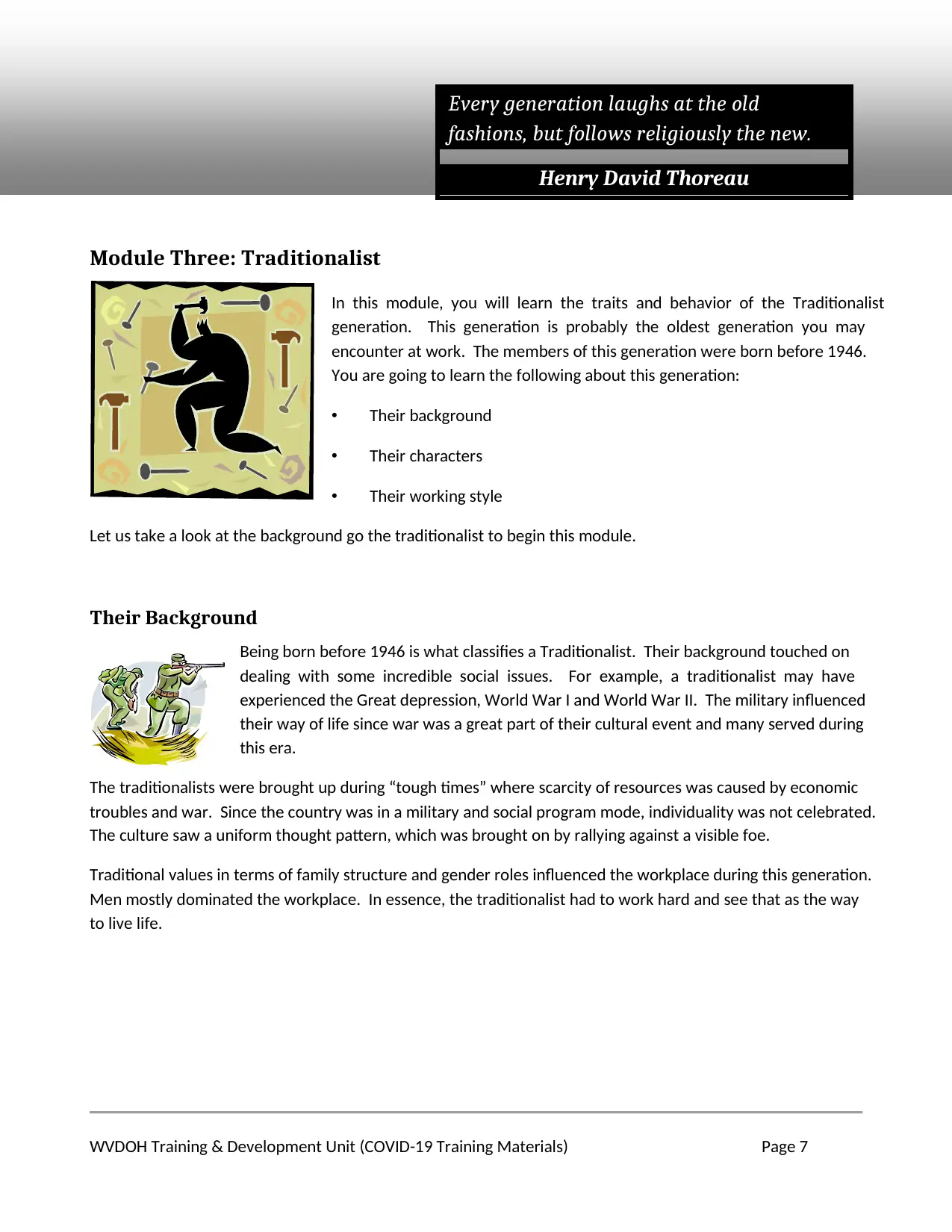
WVDOH Training & Development Unit (COVID-19 Training Materials) Page 7
Module Three: Traditionalist
In this module, you will learn the traits and behavior of the Traditionalist
generation. This generation is probably the oldest generation you may
encounter at work. The members of this generation were born before 1946.
You are going to learn the following about this generation:
• Their background
• Their characters
• Their working style
Let us take a look at the background go the traditionalist to begin this module.
Their Background
Being born before 1946 is what classifies a Traditionalist. Their background touched on
dealing with some incredible social issues. For example, a traditionalist may have
experienced the Great depression, World War I and World War II. The military influenced
their way of life since war was a great part of their cultural event and many served during
this era.
The traditionalists were brought up during “tough times” where scarcity of resources was caused by economic
troubles and war. Since the country was in a military and social program mode, individuality was not celebrated.
The culture saw a uniform thought pattern, which was brought on by rallying against a visible foe.
Traditional values in terms of family structure and gender roles influenced the workplace during this generation.
Men mostly dominated the workplace. In essence, the traditionalist had to work hard and see that as the way
to live life.
Every generation laughs at the old
fashions, but follows religiously the new.
Henry David Thoreau
Module Three: Traditionalist
In this module, you will learn the traits and behavior of the Traditionalist
generation. This generation is probably the oldest generation you may
encounter at work. The members of this generation were born before 1946.
You are going to learn the following about this generation:
• Their background
• Their characters
• Their working style
Let us take a look at the background go the traditionalist to begin this module.
Their Background
Being born before 1946 is what classifies a Traditionalist. Their background touched on
dealing with some incredible social issues. For example, a traditionalist may have
experienced the Great depression, World War I and World War II. The military influenced
their way of life since war was a great part of their cultural event and many served during
this era.
The traditionalists were brought up during “tough times” where scarcity of resources was caused by economic
troubles and war. Since the country was in a military and social program mode, individuality was not celebrated.
The culture saw a uniform thought pattern, which was brought on by rallying against a visible foe.
Traditional values in terms of family structure and gender roles influenced the workplace during this generation.
Men mostly dominated the workplace. In essence, the traditionalist had to work hard and see that as the way
to live life.
Every generation laughs at the old
fashions, but follows religiously the new.
Henry David Thoreau
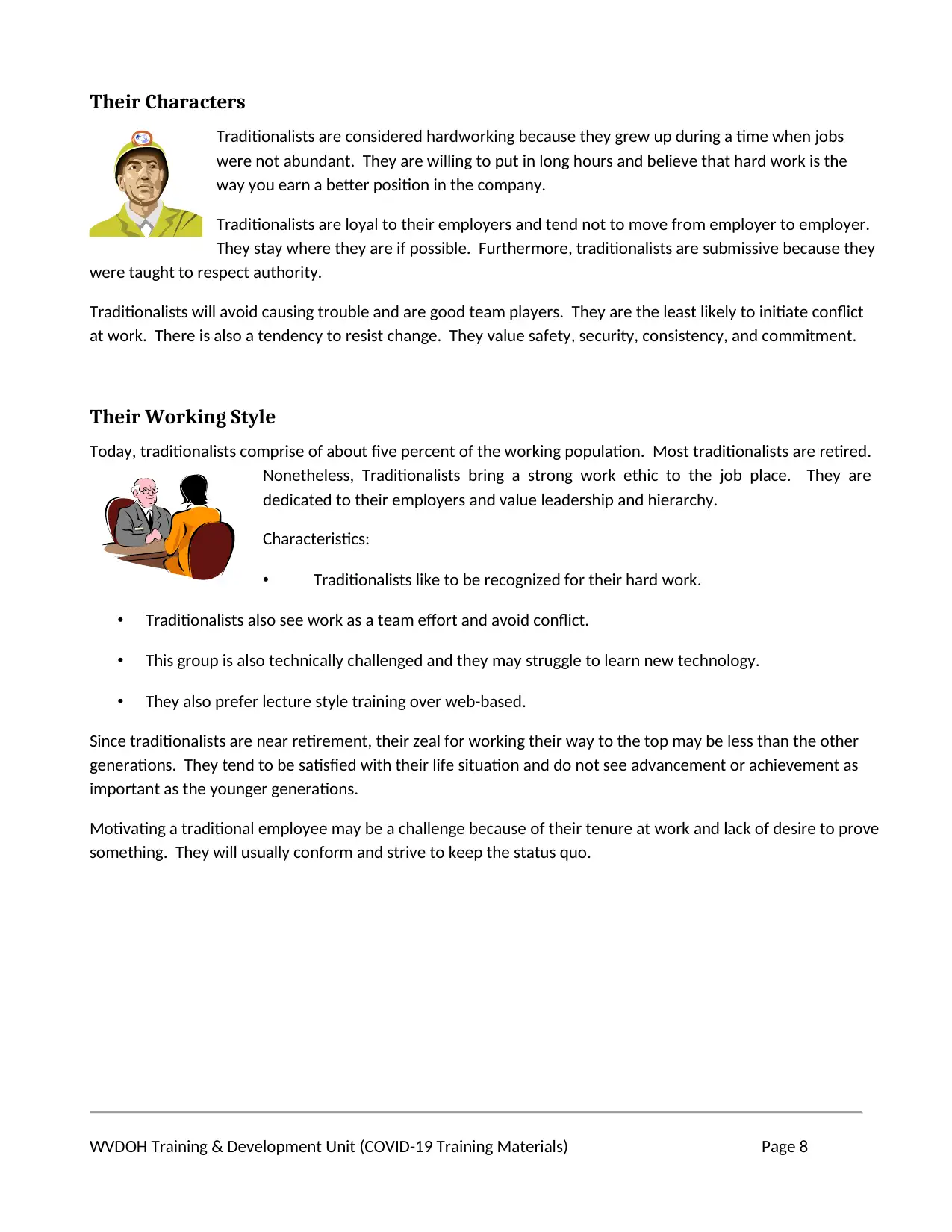
WVDOH Training & Development Unit (COVID-19 Training Materials) Page 8
Their Characters
Traditionalists are considered hardworking because they grew up during a time when jobs
were not abundant. They are willing to put in long hours and believe that hard work is the
way you earn a better position in the company.
Traditionalists are loyal to their employers and tend not to move from employer to employer.
They stay where they are if possible. Furthermore, traditionalists are submissive because they
were taught to respect authority.
Traditionalists will avoid causing trouble and are good team players. They are the least likely to initiate conflict
at work. There is also a tendency to resist change. They value safety, security, consistency, and commitment.
Their Working Style
Today, traditionalists comprise of about five percent of the working population. Most traditionalists are retired.
Nonetheless, Traditionalists bring a strong work ethic to the job place. They are
dedicated to their employers and value leadership and hierarchy.
Characteristics:
• Traditionalists like to be recognized for their hard work.
• Traditionalists also see work as a team effort and avoid conflict.
• This group is also technically challenged and they may struggle to learn new technology.
• They also prefer lecture style training over web-based.
Since traditionalists are near retirement, their zeal for working their way to the top may be less than the other
generations. They tend to be satisfied with their life situation and do not see advancement or achievement as
important as the younger generations.
Motivating a traditional employee may be a challenge because of their tenure at work and lack of desire to prove
something. They will usually conform and strive to keep the status quo.
Their Characters
Traditionalists are considered hardworking because they grew up during a time when jobs
were not abundant. They are willing to put in long hours and believe that hard work is the
way you earn a better position in the company.
Traditionalists are loyal to their employers and tend not to move from employer to employer.
They stay where they are if possible. Furthermore, traditionalists are submissive because they
were taught to respect authority.
Traditionalists will avoid causing trouble and are good team players. They are the least likely to initiate conflict
at work. There is also a tendency to resist change. They value safety, security, consistency, and commitment.
Their Working Style
Today, traditionalists comprise of about five percent of the working population. Most traditionalists are retired.
Nonetheless, Traditionalists bring a strong work ethic to the job place. They are
dedicated to their employers and value leadership and hierarchy.
Characteristics:
• Traditionalists like to be recognized for their hard work.
• Traditionalists also see work as a team effort and avoid conflict.
• This group is also technically challenged and they may struggle to learn new technology.
• They also prefer lecture style training over web-based.
Since traditionalists are near retirement, their zeal for working their way to the top may be less than the other
generations. They tend to be satisfied with their life situation and do not see advancement or achievement as
important as the younger generations.
Motivating a traditional employee may be a challenge because of their tenure at work and lack of desire to prove
something. They will usually conform and strive to keep the status quo.
⊘ This is a preview!⊘
Do you want full access?
Subscribe today to unlock all pages.

Trusted by 1+ million students worldwide

WVDOH Training & Development Unit (COVID-19 Training Materials) Page 9
Module Four: Baby Boomers
In this module, you will learn the traits and behaviors of the Baby Boomer
generation. This generation has members that were born between 1946
and 1964. You are going to learn about their background, character, and
working style. The first thing we are going to learn is the Baby Boomer
background. Let us begin.
Their Background
Baby Boomers were the product of post war efforts to absorb soldiers returning home from battle. The
government passed the GI Bill of Rights in 1944, which gave soldiers a means to obtain a
home, job and start a family.
The result was a boom in childbirths, which is where the title Baby Boomer is derived. Baby
Boomers grew up in an era of prosperity and growth in the United States. Baby Boomers
grew up mostly in suburbs and experienced a similar experience in education and
upbringing.
Baby Boomers grew up in the year of innocence during the 1950s and seen model lives portrayed on television.
Television was a large component of the Baby Boomers’ upbringing. As mothers began working outside of the
home, Baby Boomers grew up more and more with television.
As the Baby Boomers moved through the 1960s, their generation was becoming more defined. The 1960s
brought about social changes like Civil Rights, a different kind of war in Vietnam, and rebellion against
established institutions like the Hippy Revolution.
The Baby Boomer generation represents a departure from the traditional and movement towards changes in
society, beliefs, and attitudes.
Each generation goes further than the
generation preceding it because it stands
on the shoulders of that generation.
Ronald Reagan
Module Four: Baby Boomers
In this module, you will learn the traits and behaviors of the Baby Boomer
generation. This generation has members that were born between 1946
and 1964. You are going to learn about their background, character, and
working style. The first thing we are going to learn is the Baby Boomer
background. Let us begin.
Their Background
Baby Boomers were the product of post war efforts to absorb soldiers returning home from battle. The
government passed the GI Bill of Rights in 1944, which gave soldiers a means to obtain a
home, job and start a family.
The result was a boom in childbirths, which is where the title Baby Boomer is derived. Baby
Boomers grew up in an era of prosperity and growth in the United States. Baby Boomers
grew up mostly in suburbs and experienced a similar experience in education and
upbringing.
Baby Boomers grew up in the year of innocence during the 1950s and seen model lives portrayed on television.
Television was a large component of the Baby Boomers’ upbringing. As mothers began working outside of the
home, Baby Boomers grew up more and more with television.
As the Baby Boomers moved through the 1960s, their generation was becoming more defined. The 1960s
brought about social changes like Civil Rights, a different kind of war in Vietnam, and rebellion against
established institutions like the Hippy Revolution.
The Baby Boomer generation represents a departure from the traditional and movement towards changes in
society, beliefs, and attitudes.
Each generation goes further than the
generation preceding it because it stands
on the shoulders of that generation.
Ronald Reagan
Paraphrase This Document
Need a fresh take? Get an instant paraphrase of this document with our AI Paraphraser
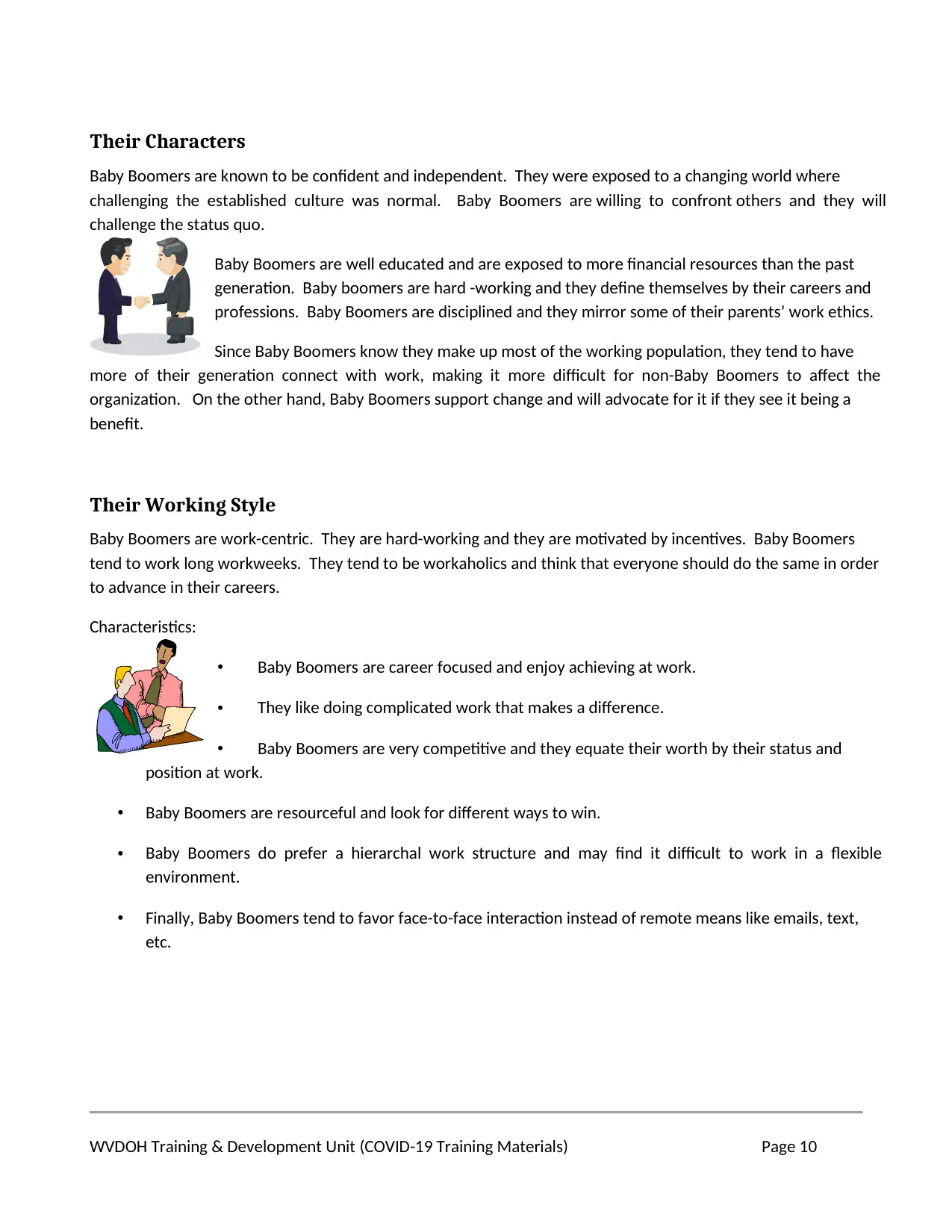
WVDOH Training & Development Unit (COVID-19 Training Materials) Page 10
Their Characters
Baby Boomers are known to be confident and independent. They were exposed to a changing world where
challenging the established culture was normal. Baby Boomers are willing to confront others and they will
challenge the status quo.
Baby Boomers are well educated and are exposed to more financial resources than the past
generation. Baby boomers are hard -working and they define themselves by their careers and
professions. Baby Boomers are disciplined and they mirror some of their parents’ work ethics.
Since Baby Boomers know they make up most of the working population, they tend to have
more of their generation connect with work, making it more difficult for non-Baby Boomers to affect the
organization. On the other hand, Baby Boomers support change and will advocate for it if they see it being a
benefit.
Their Working Style
Baby Boomers are work-centric. They are hard-working and they are motivated by incentives. Baby Boomers
tend to work long workweeks. They tend to be workaholics and think that everyone should do the same in order
to advance in their careers.
Characteristics:
• Baby Boomers are career focused and enjoy achieving at work.
• They like doing complicated work that makes a difference.
• Baby Boomers are very competitive and they equate their worth by their status and
position at work.
• Baby Boomers are resourceful and look for different ways to win.
• Baby Boomers do prefer a hierarchal work structure and may find it difficult to work in a flexible
environment.
• Finally, Baby Boomers tend to favor face-to-face interaction instead of remote means like emails, text,
etc.
Their Characters
Baby Boomers are known to be confident and independent. They were exposed to a changing world where
challenging the established culture was normal. Baby Boomers are willing to confront others and they will
challenge the status quo.
Baby Boomers are well educated and are exposed to more financial resources than the past
generation. Baby boomers are hard -working and they define themselves by their careers and
professions. Baby Boomers are disciplined and they mirror some of their parents’ work ethics.
Since Baby Boomers know they make up most of the working population, they tend to have
more of their generation connect with work, making it more difficult for non-Baby Boomers to affect the
organization. On the other hand, Baby Boomers support change and will advocate for it if they see it being a
benefit.
Their Working Style
Baby Boomers are work-centric. They are hard-working and they are motivated by incentives. Baby Boomers
tend to work long workweeks. They tend to be workaholics and think that everyone should do the same in order
to advance in their careers.
Characteristics:
• Baby Boomers are career focused and enjoy achieving at work.
• They like doing complicated work that makes a difference.
• Baby Boomers are very competitive and they equate their worth by their status and
position at work.
• Baby Boomers are resourceful and look for different ways to win.
• Baby Boomers do prefer a hierarchal work structure and may find it difficult to work in a flexible
environment.
• Finally, Baby Boomers tend to favor face-to-face interaction instead of remote means like emails, text,
etc.
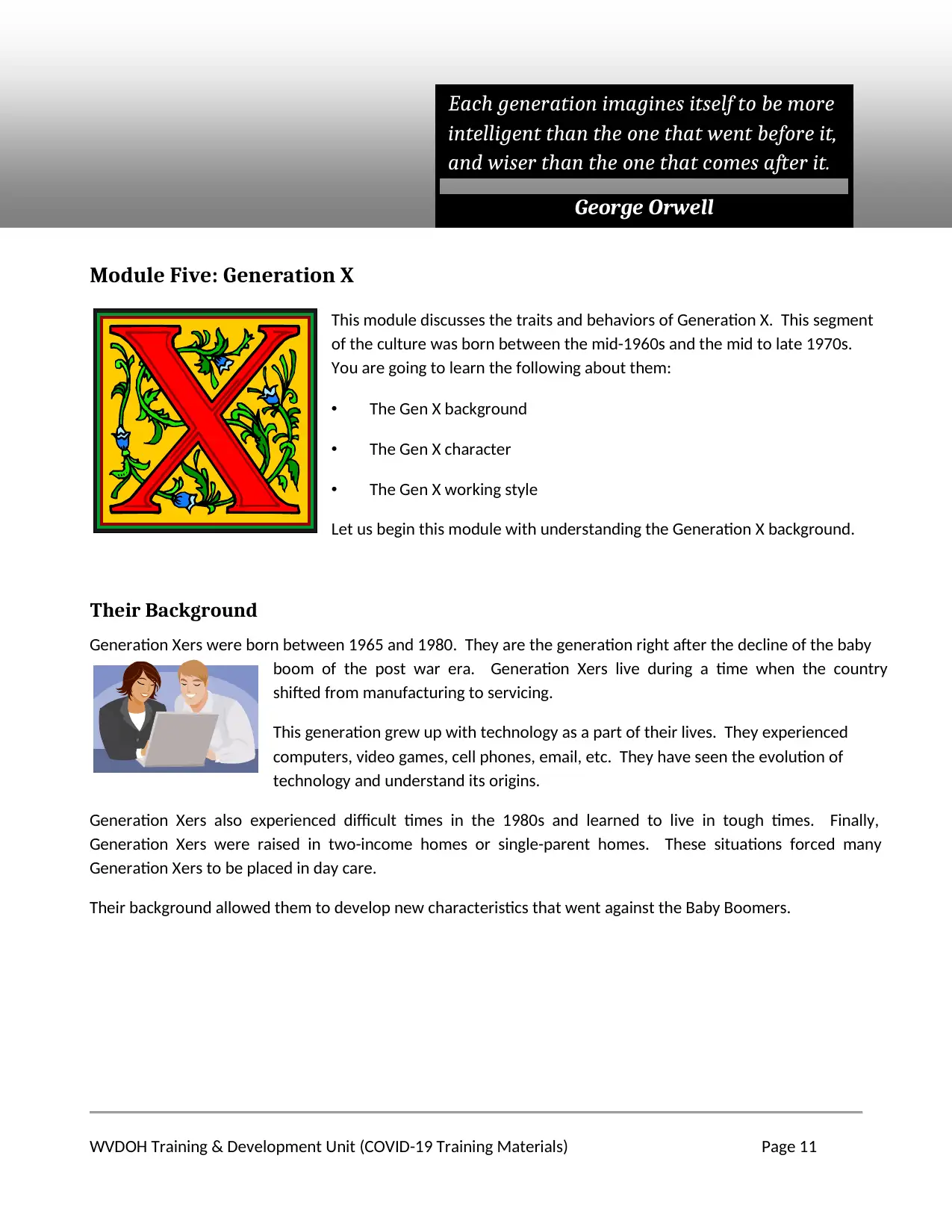
WVDOH Training & Development Unit (COVID-19 Training Materials) Page 11
Module Five: Generation X
This module discusses the traits and behaviors of Generation X. This segment
of the culture was born between the mid-1960s and the mid to late 1970s.
You are going to learn the following about them:
• The Gen X background
• The Gen X character
• The Gen X working style
Let us begin this module with understanding the Generation X background.
Their Background
Generation Xers were born between 1965 and 1980. They are the generation right after the decline of the baby
boom of the post war era. Generation Xers live during a time when the country
shifted from manufacturing to servicing.
This generation grew up with technology as a part of their lives. They experienced
computers, video games, cell phones, email, etc. They have seen the evolution of
technology and understand its origins.
Generation Xers also experienced difficult times in the 1980s and learned to live in tough times. Finally,
Generation Xers were raised in two-income homes or single-parent homes. These situations forced many
Generation Xers to be placed in day care.
Their background allowed them to develop new characteristics that went against the Baby Boomers.
Each generation imagines itself to be more
intelligent than the one that went before it,
and wiser than the one that comes after it.
George Orwell
Module Five: Generation X
This module discusses the traits and behaviors of Generation X. This segment
of the culture was born between the mid-1960s and the mid to late 1970s.
You are going to learn the following about them:
• The Gen X background
• The Gen X character
• The Gen X working style
Let us begin this module with understanding the Generation X background.
Their Background
Generation Xers were born between 1965 and 1980. They are the generation right after the decline of the baby
boom of the post war era. Generation Xers live during a time when the country
shifted from manufacturing to servicing.
This generation grew up with technology as a part of their lives. They experienced
computers, video games, cell phones, email, etc. They have seen the evolution of
technology and understand its origins.
Generation Xers also experienced difficult times in the 1980s and learned to live in tough times. Finally,
Generation Xers were raised in two-income homes or single-parent homes. These situations forced many
Generation Xers to be placed in day care.
Their background allowed them to develop new characteristics that went against the Baby Boomers.
Each generation imagines itself to be more
intelligent than the one that went before it,
and wiser than the one that comes after it.
George Orwell
⊘ This is a preview!⊘
Do you want full access?
Subscribe today to unlock all pages.

Trusted by 1+ million students worldwide
1 out of 31
Your All-in-One AI-Powered Toolkit for Academic Success.
+13062052269
info@desklib.com
Available 24*7 on WhatsApp / Email
![[object Object]](/_next/static/media/star-bottom.7253800d.svg)
Unlock your academic potential
Copyright © 2020–2025 A2Z Services. All Rights Reserved. Developed and managed by ZUCOL.

